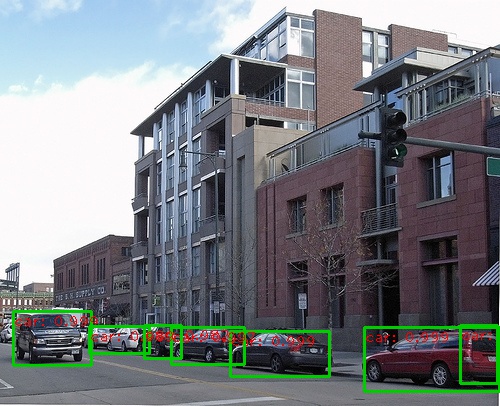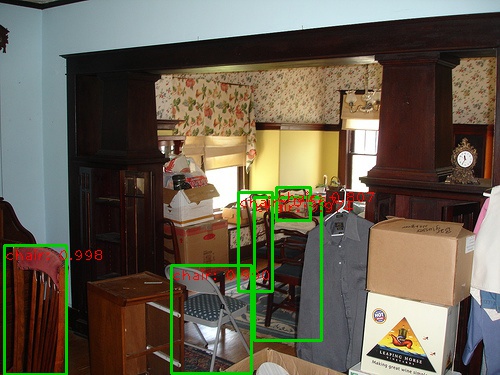This project is a faster faster R-CNN implementation, aimed to accelerating the training of faster R-CNN object detection models. Recently, there are a number of good implementations:
-
rbgirshick/py-faster-rcnn, developed based on Pycaffe + Numpy
-
longcw/faster_rcnn_pytorch, developed based on Pytorch + Numpy
-
endernewton/tf-faster-rcnn, developed based on TensorFlow + Numpy
-
ruotianluo/pytorch-faster-rcnn, developed based on Pytorch + TensorFlow + Numpy
During our implementing, we referred the above implementations, especailly longcw/faster_rcnn_pytorch. However, our implementation has several unique and new features compared with the above implementations:
-
It is pure Pytorch code. We convert all the numpy implementations to pytorch.
-
It supports trainig batchsize > 1. We revise all the layers, including dataloader, rpn, roi-pooling, etc., to train with multiple images at each iteration.
-
It supports multiple GPUs. We use a multiple GPU wrapper (nn.DataParallel here) to make it flexible to use one or more GPUs, as a merit of the above two features.
-
It supports three pooling methods. We integrate three pooling methods: roi pooing, roi align and roi crop. Besides, we convert them to support multi-image batch training.
-
It is memory efficient. We limit the image aspect ratio, and group the image in batch with similar aspect ratio. We can train resnet101 and VGG16 with batchsize = 4 (4 images) on a sigle Titan X 12 GB. When training with 8 GPU, the maximum batchsize for each GPU is 3 images (Res101), with total batchsize = 24.
-
It is faster. Based on the above modifications, the training is faster. We report the training speed on NVIDIA TITAN Xp in the tables below.
We benchmark our code thoroughly on three datasets: pascal voc, coco and imagenet-200, using two different network architecture: vgg16 and resnet101. Below are the results:
1). PASCAL VOC 2007 (Train/Test: 07trainval/07test, scale=600, ROI Pooling/ROI Crop)
| model | GPUs | Batch Size | lr | lr_decay | max_epoch | Speed/epoch | Memory/GPU | mAP |
|---|---|---|---|---|---|---|---|---|
| VGG-16 | 1 TitanX | 1 | 1e-3 | 5 | 7 | 0.76 hr | 3265MB | 71.0 |
| VGG-16 | 1 TitanX | 4 | 4e-3 | 8 | 10 | 0.50 hr | 9083MB | 70.7 |
| VGG-16 | 8 TitanX | 16 | 1e-2 | 8 | 10 | 0.19 hr | 5291MB | 69.6 |
| VGG-16 | 8 TitanX | 24 | 1e-2 | 10 | 11 | 0.16 hr | 11303MB | 69.6 |
| Res-101 | 1 TitanX | 1 | 1e-3 | 5 | 7 | 0.88 hr | 3200 MB | 75.4 |
| Res-101 | 1 TitanX | 4 | 4e-3 | 8 | 10 | 0.60 hr | 9700 MB | 74.8 |
| Res-101 | 8 TitanX | 16 | 1e-2 | 8 | 10 | 0.23 hr | 8400 MB | 74.4 |
| Res-101 | 8 TitanX | 24 | 1e-2 | 10 | 12 | 0.17 hr | 10327MB | 74.5 |
2). COCO (Train/Test: coco_train/coco_test, scale=800, ROI Align)
| model | GPUs | Batch Size | lr | lr_decay | max_epoch | Speed/epoch | Memory/GPU | mAP |
|---|---|---|---|---|---|---|---|---|
| VGG-16 | 8 TitanX | 16 | 1e-2 | 4 | 6 | 4.9 hr | 7192 MB | 29.2 |
| Res-101 | 8 TitanX | 16 | 1e-2 | 4 | 6 | 6.0 hr | 10956 MB | 36.7 |
-
Run systematical experiments on PASCAL VOC 07/12, COCO, ImageNet, Visual Genome (VG) with different settings.
-
Write a detailed report about the new stuffs in our implementations, and the quantitative results in our experiments.
First of all, create a folder:
mkdir data
-
PASCAL_VOC 07+12: Please follow the instructions in py-faster-rcnn to prepare VOC datasets. Actually, you can refer to any others. After downloading the data, creat softlinks in the folder data/.
-
COCO: Please also follow the instructions in py-faster-rcnn to prepare the data.
-
Visual Genome: Please follow the instructions in bottom-up-attention to prepare Visual Genome dataset. You need to download the images and object annotation files first, and then perform proprecessing to obtain the vocabulary and cleansed annotations based on the scripts provided in this repository.
We used two pretrained models in our experiments, VGG and ResNet101. You can download these two models from:
-
VGG16: https://www.dropbox.com/s/s3brpk0bdq60nyb/vgg16_caffe.pth?dl=0
-
ResNet101: https://www.dropbox.com/s/iev3tkbz5wyyuz9/resnet101_caffe.pth?dl=0
Download them and put them into the data/.
NOTE. We compare the pretrained models from Pytorch and Caffe, and surprisingly find Caffe pretrained models have slightly better performance than Pytorch pretrained. We would suggest to use Caffe pretrained models from the above link to reproduce our results.
If you want to use pytorch pre-trained models, please remember to transpose images from BGR to RGB, and also use the same data transformer (minus mean and normalize) as used in pretrained model.
Compile the dependencies using following simple commands:
cd lib
sh make.sh
It will compile all the modules you need, including NMS, ROI_Pooing, ROI_Align and ROI_Crop. The default version is compiled with Python 2.7, please compile by yourself if you are using a different python version.
Before training, set the right directory to save and load the trained models. Change the arguments "save_dir" and "load_dir" in trainval_net.py and test_net.py to adapt to your environment.
To train a faster R-CNN model with vgg16 on pascal_voc, simply run:
CUDA_VISIBLE_DEVICES=$GPU_ID python trainval_net.py --dataset pascal_voc --net vgg16 --cuda --bs $BATCH_SIZE
where 'bs' is the batch size with default 1. Alternatively, to train with resnet101 on pascal_voc, simple run:
CUDA_VISIBLE_DEVICES=$GPU_ID python trainval_net.py --dataset pascal_voc --net resnet101 --cuda --bs $BATCH_SIZE --num_workers $WORKER_NUMBER
Above, BATCH_SIZE and WORKER_NUMBER can be set adaptively according to your GPU memory size. On Titan Xp with 12G memory, it can be up to 4.
If you have multiple (say 8) Titan Xp GPUs, then just use them all! Try:
python trainval_net.py --dataset pascal_voc --net vgg16 --cuda --mGPUs --bs 24 --num_workers 8
Change dataset to "coco" or 'vg' if you want to train on COCO or Visual Genome.
If you want to evlauate the detection performance of a pre-trained vgg16 model on pascal_voc test set, simply run
python test_net.py --dataset pascal_voc --net vgg16 --checksession $SESSION --checkepoch $EPOCH --checkpoint $CHECKPOINT --cuda
Specify the specific model session, chechepoch and checkpoint, e.g., SESSION=1, EPOCH=6, CHECKPOINT=416.
If you want to run detection on your own images with a pre-trained model, add your own images to folder $ROOT/images, and then try
python demo.py --net vgg16 --checksession $SESSION --checkepoch $EPOCH --checkpoint $CHECKPOINT --cuda
Then you will find the detection results in folder $ROOT/images.
Below are some detection results:
This project is equally contributed by Jianwei Yang and Jiasen Lu.
@article{jjfaster2rcnn,
Author = {Jianwei Yang and Jiasen Lu, Dhruv Batra, Devi Parikh},
Title = {A Faster Pytorch Implementation of Faster R-CNN},
Journal = {https://github.com/jwyang/faster-rcnn.pytorch},
Year = {2017}
}
@inproceedings{renNIPS15fasterrcnn,
Author = {Shaoqing Ren and Kaiming He and Ross Girshick and Jian Sun},
Title = {Faster {R-CNN}: Towards Real-Time Object Detection
with Region Proposal Networks},
Booktitle = {Advances in Neural Information Processing Systems ({NIPS})},
Year = {2015}
}

